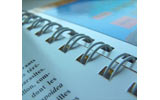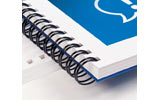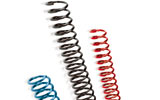The difference between 2:1, 3:1 & 4:1 pitches of Binding Wires
If you've never bought a wire binding machine before then you may not be aware of the huge range of wires available for these machines. There are literally thousands of products available that most companies don't bother to display on their website as it
is a very time consuming process. We have the largest selection of binding wires in the UK, however this can make choosing a daunting task. Here we will try to explain the various categories and offer useful advice to help you choose including an explanation of
2:1 and 3:1 pitches which might not be immediately obvious.
2:1 binding wires (if read aloud would be two to one) means that the wires will thread through 2 holes per inch of a document (typically 16 loops for A5 & 23 for A4). The looped wire will therefore be spaced further apart
than other pitches. 2:1 binding wires can accept more sheets of paper and therefore tend to be the most popular of the two pitches.
View our full range of 2:1 Binding Wires here
3:1 binding wires (if read aloud would be three to one) means that the wires will thread through 3 holes per inch of a document (typically 24 loops for A5 & 34 for A4). The looped wire will therefore be spaced more closely
together than the 2:1 pitch giving the wires a much tighter look. It is worth noting that 3:1 binding wires can accept fewer sheets of paper than 2:1 wires.
View our full range of 3:1 Binding Wires here
Binding coils have a 4:1 pitch (if read aloud would be four to one) means that the wires will thread through 4 holes per inch of a document (typically 32 loops for A5 & 45 for A4). The looped wire will therefore be spaced even more closely
together than both the 3:1 & 2:1 pitches giving the wires a much tighter look. It is worth noting that 4:1 binding wires can accept fewer sheets of paper than both the 3:1 & 2:1 wires.
View our full range of Binding Coils here






























